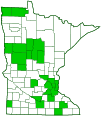stilt-legged fly
(Rainieria antennaepes)
Conservation • Description • Habitat • Ecology • Distribution • Taxonomy
Conservation Status |
|
|||||||
| IUCN Red List | not listed |
|||||||
| NatureServe | not listed |
|||||||
| Minnesota | not listed |
|||||||
Description |
||
Rainieria antennaepes is a relatively uncommon stilt-legged fly. It is a medium-sized fly but a large stilt fly. It is the only species in the genus Rainieria in North America. It occurs in the United States and southern Canada east of the Great Plains. Adults are found from early June to mid-August on foliage, on the bark of trees, or flying around in woodlands. Larvae are found in dung. Adults are 5⁄16″ to ⅜″ (8 to 10 mm) in length. The body is long, slender, and entirely black except for the legs and antennae. The head is round. The face is short. There are two large compound eyes and three small simple eyes (ocelli). The compound eyes are bright red and are not striped. They do not meet at the top of the head on either sex. The plate on the face (clypeus) is large, prominent, and broader than long. The antennae are short and yellow to brown. The second segment is almost as long as the third segment. It has long hairs (setae) on the lower margin. It does not have a longitudinal groove (suture) on the upper side. The third antennal segment is short and egg-shaped. It has a long, forward-pointing bristle (arista) on the upper side. The antennae bases are relatively close together. There are no stiff, whisker-like, sensory hairs (vibrissae) around the mouth. The thorax is much longer than high. The legs are long, stilt-like, and mostly pale. The front legs are shorter than the middle and hind legs. On the front legs there is a dark brown ring at the end of the third leg segment (femur). The last part of the leg (tarsus), corresponding to the foot, is usually entirely white, but sometimes the terminal segment is dark. On the femur of the middle and hind legs there is a broad dark brown ring beyond the middle and a narrow dark brown ring near the end. On the hind leg the base of the tarsus is sometimes white. The wings are clear except for a large, triangular, faint but noticeable brown spot beyond the middle, and a small brown spot at the wingtip. The subcostal vein (Sc) is complete. The basal crossvein is present, making the discal and basal cells complete. The anal cell is short. The first posterior cell is open. The R5 cell is narrowed at the end. |
||
Size |
||
Total length: 5⁄16″ to ⅜″ (8 to 10 mm) |
||
Similar Species |
||
Habitat |
||
|
||
Ecology |
||
Season |
||
Early June to mid-August (CCESR) |
||
Behavior |
||
Rainieria antennaepes is a mimic of a predatory ichneumonid wasp. It frequently holds it front legs up and forward, vibrating them, mimicking a wasp’s antennae. |
||
Life Cycle |
||
|
||
Larva Food |
||
Dung |
||
Adult Food |
||
|
||
Distribution |
||||
|
Sources Cresson, E. T. (1938). The Neriidae and Micropezidae of America North of Mexico (Diptera). Transactions of the American Entomological Society (1890-), 64(4), 293–366. http://www.jstor.org/stable/25077421 |
|||
| 1/12/2023 | ||||
Occurrence |
||||
Relatively uncommon |
||||
Taxonomy |
|||
Order |
Diptera (Flies) | ||
Suborder |
Brachycera | ||
| Infraorder | Cyclorrhapha | ||
| Zoosection | Schizophora | ||
| Zoosubsection | Acalyptratae (acalyptrate flies) | ||
Superfamily |
Nerioidea | ||
Family |
Micropezidae (stilt-legged flies) | ||
Subfamily |
Taeniapterinae | ||
Genus |
Rainieria | ||
Synonyms |
|||
Calobata antennaepes |
|||
Common Names |
|||
This species has no common name. The name of the family Micropezidae is stilt-legged flies, and it is applied here for convenience. |
|||
Glossary
Arista
A large bristle on the upper side of the third segment of the antenna of a fly. Plural: aristae.
Clypeus
On insects, a hardened plate on the face above the upper lip (labrum).
Femur
On insects and arachnids, the third, largest, most robust segment of the leg, coming immediately before the tibia. On humans, the thigh bone.
Ocellus
Simple eye; an eye with a single lens. Plural: ocelli.
Seta
A stiff, hair-like process on the outer surface of an organism. In Lepidoptera: A usually rigid bristle- or hair-like outgrowth used to sense touch. In mosses: The stalk supporting a spore-bearing capsule and supplying it with nutrients. Plural: setae. Adjective: setose.
Tarsus
On insects, the last two to five subdivisions of the leg, attached to the tibia; the foot. On spiders, the last segment of the leg. Plural: tarsi.
Visitor Photos |
|||||
Share your photo of this insect. |
|||||
| This button not working for you? Simply email us at info@MinnesotaSeasons.com. Attach one or more photos and, if you like, a caption. |
|||||
Alfredo Colon |
|||||
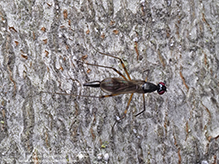 |
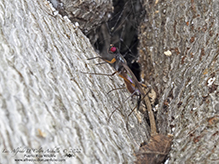 |
||||
Babette Kis |
|||||
Rainieria antennaepes stilt-legged fly Rainieria antennaepes, stilt-legged fly, found at a hedgerow next to Barnes Prairie, Racine Co., WI. Photos were taken on July 19, 2022. |
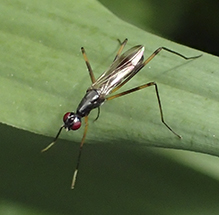 |
||||
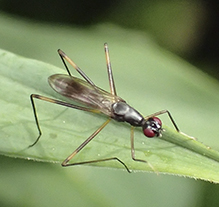 |
|||||
MinnesotaSeasons.com Photos |
|||||
|
|||||

Visitor Videos |
|||
Share your video of this insect. |
|||
| This button not working for you? Simply email us at info@MinnesotaSeasons.com. Attach a video, a YouTube link, or a cloud storage link. |
|||
Other Videos |
|||
| Stilt-legged Fly - Rainieria antennaepes Randy's Natural World |
|||
About
Jun 6, 2022 his is a brief video about a species of Stilt-legged Fly -- Rainieria antennaepes. |
|||
| Stilt-legged Fly - Rainieria antennaepes Stoil Ivanov |
|||
About
Jun 7, 2021 Stilt-legged Fly ( Rainieria antennaepes ) displaying , dancing or mimicking wasps? Very common sight in the forest if anyone bothers to look. video taken on 6-06-2021 at Ryerson Woods, Illinois. I do understand that most people don't care about small annoying things like flies for example - but at the same time how many have seen it at macro level? |
|||
| STILT-LEGGED FLY semaphoring. Rainieria antennaepes Rob Curtis |
|||
About
Jul 26, 2017 Rainieria antennaepes = STILT-LEGGED FLY semaphoring in an unknown language. Maybe like Morse Code . Waterfall Glen FP, IL 6/22/2017. |
|||


Created: 1/12/2023
Last Updated:
